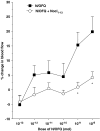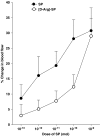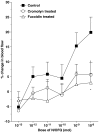Stimulation of sensory neuropeptide release by nociceptin/orphanin FQ leads to hyperaemia in acutely inflamed rat knees
- PMID: 16783411
- PMCID: PMC1751929
- DOI: 10.1038/sj.bjp.0706804
Stimulation of sensory neuropeptide release by nociceptin/orphanin FQ leads to hyperaemia in acutely inflamed rat knees
Abstract
The peripheral effect of the 'opioid-like' peptide nociceptin/orphanin FQ (N/OFQ) on joint blood flow was investigated in acutely inflamed rats. Sensory neuropeptide release from capsaicin-sensitive nerves and the involvement of synovial mast cells and leukocytes on these vasomotor responses were also studied. Blood flow measurements of exposed knee joints were performed in urethane-anaesthetised rats (2 mg kg(-1) intraperitoneal) using laser Doppler perfusion imaging. Topical administration of N/OFQ (10(-13)-10(-8) mol) to acutely inflamed joints caused a dose-dependent increase in synovial perfusion with an ED(50) of 4.0 x 10(-10) mol. This vasodilatatory response was blocked by the selective NOP receptor antagonist [Phe(1)-(CH(2)-NH)-Gly(2)]-Nociceptin(1-13)-NH(2) (10(-9) mol) (P<0.0001).Co-administration of N/OFQ with the neurokinin-1 (NK(1)) receptor antagonist [D-Arg1,D-Phe5,D-Trp7,9,Leu11]-Substance P (10(-12) mol), the vasoactive intestinal peptide (VIP) receptor antagonist VIP(6-28) (10(-9) mol) or the calcitonin gene-related peptide (CGRP) receptor antagonist CGRP(8-37) (10(-9) mol) all blocked the hyperaemic effect of N/OFQ (P<0.0001). Treatment of acutely inflamed knees with capsaicin (8-methyl-N-vanillyl-6-noneamide) to destroy unmyelinated joint afferents also inhibited N/OFQ vasomotor activity. Stabilisation of synovial mast cells with disodium cromoglycate (cromolyn) ameliorated N/OFQ responses, whereas inactivation of circulating leukocytes with the pan-selectin inhibitor fucoidin completely blocked N/OFQ-induced hyperaemia in these joints. These experiments show that in acutely inflamed knee joints, N/OFQ acts on NOP receptors located on synovial mast cells and leukocytes leading to the secondary release of proinflammatory mediators into the joint. These agents subsequently stimulate sensory neuropeptide release from capsaicin-sensitive nerves culminating in vasodilatation and increased articular blood flow.
Figures







References
-
- ACKERMANN P.W., SPETEA M., NYLANDER I., PLOJ K., AHMED M., KREICBERGS A. An opioid system in connective tissue. A study of achilles tendon in the rat. J. Histochem. Cytochem. 2001;49:1387–1396. - PubMed
-
- ANDOH T., ITOH M., KURAISHI Y. Nociceptin gene expression in rat dorsal root ganglia induced by peripheral inflammation. Neuroreport. 1997;8:2793–2796. - PubMed
-
- ARNDT M.L., WU D., SOONG Y., SZETO H.H. Nociceptin/orphanin FQ increases blood pressure and heart rate via sympathetic activation in sheep. Peptides. 1999;20:465–470. - PubMed
-
- BIGONI R., GIULIANI S., CALO G., RIZZI A., GUERRINI R., SALVADORI S., REGOLI D., MAGGI C.A. Characterization of nociceptin receptors in the periphery: in vitro and in vivo studies. Naunyn-Schmiedeberg's Arch. Pharmacol. 1999;359:160–167. - PubMed
-
- CARPENTER K.J., VITHLANI M., DICKENSON A.H. Unaltered peripheral excitatory actions of nociceptin contrast with enhanced spinal inhibitory effects after carrageenan inflammation: an electrophysiological study in the rat. Pain. 2000;85:433–441. - PubMed
Publication types
MeSH terms
Substances
LinkOut - more resources
Full Text Sources
Other Literature Sources
Research Materials
Miscellaneous

